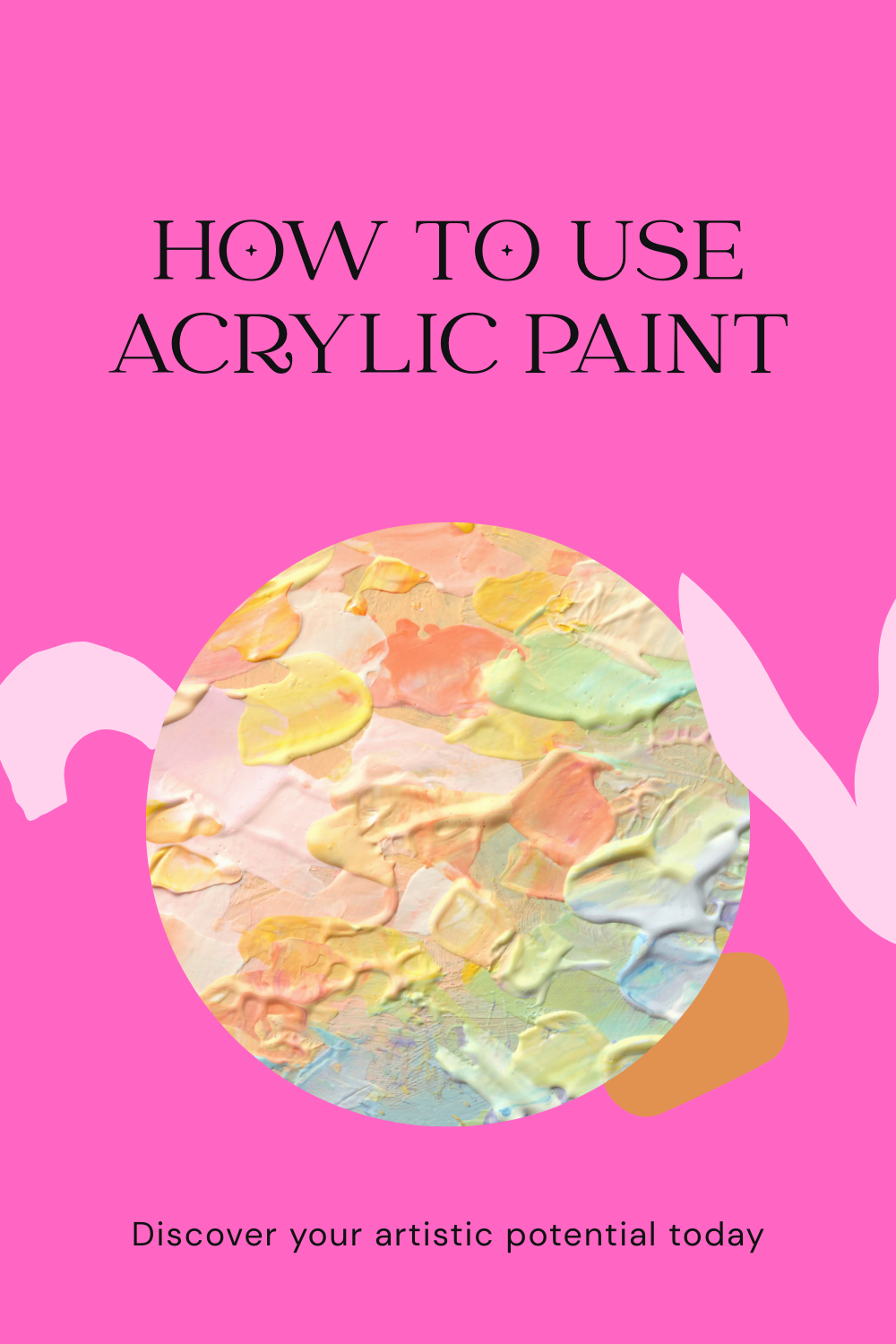Are you an acrylic artist who loves the rich colors and versatility of acrylic paint but yearns for the delicate, fluid feel of watercolor? If so, you’re not alone.
Many artists appreciate the vibrant pigments and texture that acrylic paint offers but find themselves drawn to the soft, transparent effects that watercolors can achieve.
Fortunately, you don’t have to choose between the two. With the right techniques and a bit of creativity, you can use acrylic paint like watercolor and get the best of both worlds.
In this guide, I’ll show you how to make acrylic paint behave like watercolor. Whether you’re a beginner or an experienced artist, these tips and techniques will help you explore new creative possibilities with your acrylics.
From understanding the basics of acrylic paint to mastering the tricks that create watercolor-like effects, this article will cover everything you need to know.

Table: Acrylic Paint vs. Watercolor Paint
| Feature | Acrylic Paint | Watercolor Paint |
| Composition | Pigments in acrylic polymer emulsion | Pigments in water-soluble binder (gum arabic) |
| Transparency | Opaque, but can be thinned for more transparency | Highly transparent, allowing layers beneath to show through |
| Drying Time | Fast-drying (15-30 minutes) | Slow-drying, can be reworked for longer periods |
| Finish | Matte or glossy, depending on medium used | Typically glossy or satin, depending on paper used |
| Application Surface | Canvas, acrylic paper, wood, and more | Watercolor paper (300gsm or above) |
| Water Solubility | Can be thinned with water or acrylic medium | Thinned with water, can be used for washes and glazes |
| Opacity | Can be opaque or transparent depending on dilution | Mostly transparent, layers build up gradually |
| Color Intensity | Intense, but can be lightened or modified with medium | Intense in first layers, fades when diluted |
| Layering Technique | Works well with layering and glazing (wet-on-dry method) | Best suited for layering transparent washes (wet-on-wet) |
| Common Techniques | Glazing, wet-on-wet, dry brushing | Wet-on-wet, wet-on-dry, lifting, glazes |
The Basics of Acrylics and Watercolors: What’s the Difference?
Before diving into the methods, it’s essential to understand the key differences between acrylic paint and watercolor. Knowing these distinctions will help you work with both mediums effectively and blend them in innovative ways.
Acrylic Paint:
- Composition: Acrylics are made of pigments suspended in a synthetic polymer emulsion (acrylic polymer). This gives them their thick, viscous consistency.
- Drying Time: Acrylic paint dries quickly, usually within 15-30 minutes, depending on the thickness of the layer and environmental conditions.
- Finish: Once dry, acrylic paint has a matte or glossy finish, depending on the medium or varnish used.
- Opacity: Acrylics are generally more opaque than watercolors, but you can thin them with water or mediums to achieve a more translucent effect.
Watercolor Paint:
- Composition: Watercolors are made from pigments suspended in a water-soluble binder (usually gum arabic), making them thin and fluid.
- Drying Time: Watercolors dry relatively slowly compared to acrylics, allowing for more blending time.
- Finish: Watercolors have a more translucent, glossy, or satin finish that allows the underlying paper texture to show through.
- Transparency: Watercolors are highly transparent, allowing light to pass through the layers, which creates their signature ethereal look.
Key Similarities:
- Both acrylics and watercolors are water-based paints, meaning they can be thinned with water and can create similar fluid effects.
- Both can be applied in layers, allowing artists to build up colors gradually.
How to Prepare Acrylic Paint for Watercolor Effects
To use acrylic paint like watercolor, you’ll need to adjust the paint’s consistency and learn how to control the amount of water you use. This section will walk you through the necessary steps to prepare your acrylics for watercolor-like effects.
1. Thin Your Acrylic Paint
The key to getting acrylics to behave like watercolors is thinning them down. To achieve that fluid, transparent effect, you’ll need to mix your acrylic paint with water or acrylic medium. Here’s how to do it:
- Mixing Acrylic with Water: Start by adding a little bit of water to your acrylic paint. You’ll want the consistency to be runny but not too watery. The more water you add, the more transparent the paint will be.
- Using Acrylic Flow Mediums: If you want to maintain the paint’s vibrancy while thinning it, consider using an acrylic flow medium. This will thin the paint without affecting its color intensity.
2. Choose the Right Surface
Watercolor paintings are typically done on special watercolor paper, but since you’re working with acrylics, you’ll want a surface that can handle the extra moisture.
Look for heavy-duty watercolor paper (300gsm or above) or acrylic paper, which has been designed to absorb moisture without warping. These surfaces will allow the paint to flow smoothly while avoiding excessive pooling or lifting.
Step-by-Step Guide: Techniques for Using Acrylics Like Watercolors
1. The Wet-on-Wet Technique
Now that your acrylics are ready to mimic the transparency and flow of watercolors, let’s explore several techniques you can use to achieve watercolor-like effects.
The wet-on-wet technique is the hallmark of watercolor painting, and you can replicate this with acrylic paint. Here’s how:
- Step 1: Wet your paper or canvas using a clean brush or sponge.
- Step 2: Thin your acrylic paint with water or medium until it’s a milky consistency.
- Step 3: While the surface is still wet, apply the thinned acrylic paint. The paint will spread and mix on the wet surface, just like watercolors do.
2. The Wet-on-Dry Technique
If you prefer more control over the application, the wet-on-dry technique can also be applied to acrylics. Here’s how:
- Step 1: Allow your first layer of acrylic paint to dry completely.
- Step 2: Thin your paint to the desired transparency, then apply it over the dry layer.
- Step 3: You’ll notice the paint behaves more like watercolor, with the underlying layers slightly showing through.
This technique is great for layering colors and creating depth, while still achieving that light, airy watercolor feel.
3. Glazing
Glazing is a method where you apply a thin, transparent layer of paint over a dry layer. This technique creates rich, vibrant color effects that resemble watercolor washes.
- Step 1: Allow your base layer to dry completely.
- Step 2: Thin your acrylic paint with water or medium to create a translucent glaze.
- Step 3: Apply the glaze over the dry base layer, letting it subtly alter the tone and color without covering the underlying layer entirely.
Glazing can add a dreamy, layered look to your acrylic painting, similar to the way watercolors build depth through multiple transparent layers.
4. Soft Washes and Lifting
Watercolorists often use the technique of lifting to create soft transitions or remove color. You can replicate this with acrylic paint:
- Step 1: Thin your acrylic paint to a watery consistency.
- Step 2: Apply the paint in sweeping, soft strokes.
- Step 3: Before the paint dries completely, use a damp sponge or brush to lift some color off the paper. This will create lighter areas and soft gradients.
Quick Reference for Using Acrylics Like Watercolor
| Technique | How to Achieve with Acrylics |
| Wet-on-Wet | Wet your surface first, then apply thinned acrylics |
| Wet-on-Dry | Apply thinned acrylics over a dry layer |
| Glazing | Apply a thin, transparent layer of acrylics over a dry base |
| Soft Washes and Lifting | Apply thinned paint, then lift it off with a damp sponge |
| Layering | Build up multiple layers of thinned acrylic for depth |
Common Mistakes to Avoid
While using acrylics like watercolors opens up a new world of artistic possibilities, there are a few mistakes that can derail your efforts. Here are some common mistakes to watch out for:
1. Using Too Much Water
Acrylics can be tricky when thinned too much. If you add excessive water, the paint might lose its pigmentation, leaving you with pale, washed-out colors. Remember, a little goes a long way!
2. Not Using the Right Surface
Acrylics require a more absorbent surface than traditional watercolor paper. Using a too-smooth or too-thin surface can cause the paint to pool or bead up, creating uneven washes. Choose a surface that can handle the moisture and weight of acrylics.
3. Overworking the Paint
Watercolor artists are known for their spontaneity and the unpredictability of the medium. If you overwork your acrylics like watercolors, the paint may become muddy. Try to avoid excessive brushing or scrubbing, as this can disturb the layers of color and texture.
Conclusion
Using acrylic paint like watercolor is a fantastic way to experiment with new textures and effects. By adjusting your approach and applying the right techniques, you can mimic the delicate transparency and fluidity that make watercolors so beautiful.
Remember to practice and experiment, and soon you’ll be able to create breathtaking pieces that combine the best of both worlds.
Key Takeaways:
- Thin your acrylics with water or flow medium to achieve a watercolor-like consistency.
- Use techniques like wet-on-wet, glazing, and lifting to create transparent, fluid layers.
- Be mindful of the surface you’re painting on to prevent issues with paint absorption and pooling.
- Avoid common mistakes, such as using too much water or overworking the paint.
I encourage you to give these techniques a try in your next acrylic painting. Whether you’re working on a still life, landscape, or abstract piece, these methods will give you the chance to explore a whole new side of acrylics.
Frequently Asked Questions (FAQs)
Q1: Can I use any type of acrylic paint for watercolor effects?
A1: Yes, you can use any acrylic paint, but for smoother blending and better transparency, it’s a good idea to use high-quality professional acrylic paints. These tend to have better pigmentation and work more effectively for watercolor-like effects.
Q2: What’s the best type of paper to use for acrylics like watercolors?
A2: The best paper is a heavy-duty watercolor paper (300gsm or more), or specialized acrylic paper. These types of paper will handle the extra moisture without warping or buckling.
Q3: Can I use acrylic paint in place of watercolors for all techniques?
A3: While acrylic paint can mimic many watercolor techniques, some aspects like lifting and flow might be more challenging to replicate. Acrylics also dry faster than watercolors, so you’ll need to work quickly to achieve similar effects.



